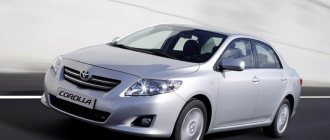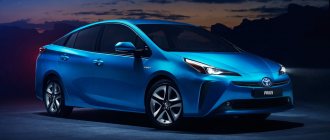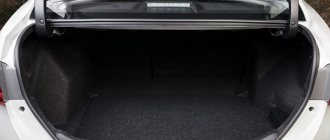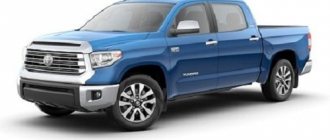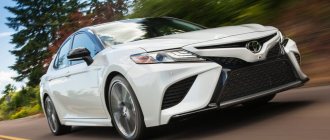There is hardly a driver who would be indifferent to the fuel consumption of a car. The so-called bestsellers of their class are of particular interest. Let's consider this important indicator for the relatively small Toyota RAV4 all-terrain vehicle - one of the pioneers of the SUV auto variation.
The 1st generation Japanese model rolled off the production line a quarter of a century ago - in 1994. The first RAV4 immediately gained fame as a fairly economical car. The four in the name indicated that it was equipped with two driving wheelsets. Although only some trim levels have all-wheel drive. Currently, owners are already using 4th generation cars.
If we take 10 liters as the average or purely psychological value of fuel consumption per hundred kilometers, then with less consumption we can talk about good performance. When consumption begins to show more than the ten-liter mark, explanations are needed.
Recently, fuel consumption is considered optimal and economical when no more than 6 liters are consumed over a distance of one hundred kilometers.
The fuel consumption range of the RAV 4 is quite wide and ranges from 5.4 to 12.2 liters per hundred kilometers.
This car is manufactured to run on the following brands of gasoline:
- AI – 95 and 92;
- Regular;
- Premium (AI-98);
In addition to the gasoline car, a diesel version is also available, naturally running on diesel fuel.
Official fuel consumption data for Toyota Rav 4 (l/100 km)
A car can consume different displacement, it depends on the driving conditions; when driving on highways there will be one indicator, while driving around the city it will be completely different. Also, the indicators vary between automatic transmission, manual transmission and fuel consumption.
According to official data from the manufacturer, the fuel consumption of a Toyota Rav 4 with a gasoline engine, manual transmission and 1.8 volume is:
- in city conditions - 9.4 l/100 km,
- on the motorway consumption drops to 6.2 liters.
With an automatic transmission the performance is identical.
For a two-liter gasoline engine with a manual transmission, the performance increases:
- on the highway - 6.4 l,
- in the city - 9.7 liters.
The automatic consumes more, respectively – 7.2 liters and 11.0 liters.
Diesel engines (mechanical) with this volume consume:
- on the highway 4.3 l,
- in the city - 5.4 l.
A 2.2 engine with an automatic transmission using diesel fuel consumes:
- in the city - 8.1 l,
- outside the city - 5.9 l.
With manual it’s the same.
Cars with an engine displacement of 2.4 proportionally increase fuel consumption.
Petrol with mechanics:
- in populated areas – 12.6 l,
- on highways - 7.9 l.
CVT - identical.
Fuel consumption of the Toyota Rav 4, which has a 2.5 engine on the automatic, is 11.6 liters and 6.9 liters, respectively.
How to reduce fuel consumption
To reduce fuel costs in a working car, you should maintain an average speed on the highway within 90-100 km/h, focusing on the instantaneous consumption readings in the on-board computer. It is necessary to minimize sudden accelerations and prolonged idling (for example, when sitting in traffic jams or while waiting for passengers). Overloading or operating with a trailer has a negative impact on efficiency; installing a luggage carrier on the roof or driving on tires with low pressure increases fuel consumption by 10-15%.
Generation 1 (XA10, 1994 – 2000)
The first generations of the car did not have a large selection of engines. One was installed with a volume of 2.0 liters, it ran on gasoline with a power of 135 hp. The rav4 was produced with a manual and automatic five-speed transmission.
These were front-wheel drive or all-wheel drive. Three-door Toyotas had the option of 180 hp. with all-wheel drive.
Toyota rav4 modifications and technical specifications
Depending on the modification, the trim of the chairs can be fabric, combined fabric, leather, suede or a combination of natural and artificial leather. -Expensive when compared to competing crossovers from other automakers; The infotainment system installed in the car does not keep up with the rest of the market, and when traveling in urban areas, its suspension seems quite stiff for a family SUV, so to speak, but the appearance itself is not an acquired taste.
Generation 3 (XA30, 2006 – 2010)
Since 2006, the third generation began to be produced. Three-door versions were no longer produced. Changes that the car received:
- five-door configuration;
- design change;
- increase in diesel engine volume;
- changing transmissions.
In the technical part, adjustments have been made. Diesel engines had a volume of 2.2 liters, power was possible at 134 and 175 hp. In the new version, both transmissions are six-speed and these cars are all all-wheel drive. Fuel consumption was 6.7 liters.
The gasoline engine had a volume of 2.0 liters and the power was improved to 152 hp, but fuel consumption increased to 8.7 liters. It was possible to install a drive as a choice, since both drives can be installed. The 2.4 liter engines have been boosted and it makes 170 horsepower with an automatic transmission. This car consumed 9.8 liters of fuel.
They released a new product with a 2.5 liter engine producing 179 hp. With. and front-wheel drive, fuel consumption remained unchanged compared to the previous version. The second innovation was the installation of a 3.5-liter engine with a capacity of 269 hp. This equipment was equipped with an automatic transmission and had the ability to install both drives. One of the minuses was the high gasoline consumption of 11.2 liters (automatic 4).
Toyota RAV4 2021 – a new generation of the popular crossover
The official debut of the new generation Toyota RAV 4 took place at the New York Auto Show in the spring of 2021. The 5th generation of the model has received a completely new look. The exterior of the crossover is designed in a strict and aggressive style. The car is built on the basis of the new TNGA K trolley. The start of sales of the Toyota RAV4 in a new body overseas is the end of 2021. The price of the new Toyota RAV 4 2018-2019 has not yet been disclosed. According to experts, you will have to pay about 25 thousand US dollars for the basic version of the model.
Sales of the 5th generation Toyota RAV4 on the European market will start in the spring of 2021, and the car will reach Russia only at the end of 2019. They plan to assemble the crossover at the Toyota plant in St. Petersburg. I would like to remind you that the Toyota RAV 4 is in great demand among buyers. Thus, throughout 2021, the Japanese were able to sell over 408 thousand copies of the 4th generation model on the American market. The same figure in the Russian Federation was almost 33 thousand units. Do not forget that RAV4 has the highest cost in the TOP 10 market in our country.
Generation 4 (CA40, 2013 – 2015)
Starting in 2013, they began producing the fourth generation of Toyota Rav 4 models. They released a model with a 2.2-liter diesel engine with a power of 124 horsepower. This car had all-wheel drive with a manual transmission.
Fuel consumption of Toyota Rav 4 manual was 5.4 liters. Old 2.2 liter units. changed the power to 149 hp. With. Other indicators remained unchanged.
Gasoline two-liter engines reduced power to 146 hp. With. Such models can be equipped with manual transmission and CVT. Consumes 7.6 liters of fuel.
Manufacturers focused only on 2.5 liter engines. In this generation, they stopped producing Long versions and modifications with an electric motor.
Reviews of real fuel consumption of Toyota RAV 4 IV
Owners of Toyota RAV4 IV cars note that after passing the test drive, in addition to the comfortable interior and powerful engine, they were surprised and lured by the fuel consumption. Operating the car in different conditions, the driver was given clear indicators, the real fuel consumption of the Toyota Rav 4 is 8-10 liters, it depends on the driving style.
If it is aggressive, then more fuel will be consumed. A driver who has driven more than 100 thousand kilometers in this car notes that his fuel consumption is 9 liters per 100 km, which is a very economical indicator.
In addition to the excellent cross-country ability of the car, the owners note that with an engine capacity of 2.0 for the 2013 model, they only consume 8-9 liters on average. Therefore, we can summarize that the real consumption of 4 corresponds to the official data on fuel consumption.
General indicators are summarized in a table, so cars with a 2.2-liter diesel engine consume 6.7 liters per 100 km, and two-liter gasoline ones - from 7.4 liters to 8.0 liters. Petrol 2.5 liters consume 8.5 liters.
Reviews
“I first purchased a Toyota RAV4 in 2021, and I still use it. It's too early to talk about the reliability of this car, but I haven't had a single problem with it yet. I was very attracted by the fact that the car is powerful, comfortable and has the status of an SUV. Despite the impressive dimensions and powerful engine, fuel consumption is very modest - 9.5 liters,” writes Artem from Bryansk.
“My RAF 4 has already covered 120,000 kilometers and I haven’t had a single serious breakdown during this time. I have already become accustomed to the reliability and comfort of this car. For me, for this price, this is the optimal SUV with a comfortable interior and a good engine. I was very surprised by the consumption - it turned out that it was only 9-9.5 liters,” responded Georgy from Rostov-on-Don.
“I like the RAV4 for its speed characteristics - it’s playful and dynamic. I specifically chose the version with a forced engine because I love driving fast both on the highway and in the city. It also performs well on dirt roads. Despite the aggressive driving style, consumption rarely exceeds 15 liters,” wrote Denis from Murmansk.
Fifth generation Engine 22 diesel
Secondly, it looks like a purely nominal trunk, although, I remember, I was taking a friend’s sister to the airport with two suitcases; they fit vertically without any problems. As for driving style, I always try to follow traffic rules, I exceed the speed limit by 10 km/h, that is, in a populated area I drive 70 km/h, even if conditions allow me to drive more, outside a populated area I drive 100 km/h.
| Parameter | 2.0 146 hp | 2.5 180 hp | 2.2 TD 150 hp |
| Engine code | 3ZR-FE | 2AR-FE | 2AD-FHV |
| engine's type | petrol without turbocharging | diesel turbocharged | |
| Supply system | distributed injection, dual electronic valve timing control system Dual VVT-i, two camshafts (DOHC), timing chain drive | direct injection, two camshafts (DOHC), timing chain drive | |
| Number of cylinders | 4 | ||
| Cylinder arrangement | in-line | ||
| Number of valves | 16 | ||
| Cylinder diameter, mm | 80.5 | 90.0 | 86.0 |
| Piston stroke, mm | 97.6 | 98.0 | 96.0 |
| Compression ratio | 10.0:1 | 10.4:1 | 15.7:1 |
| Working volume, cubic meters cm. | 1987 | 2494 | 2231 |
| Power, hp (at rpm) | 146 (6200) | 180 (6000) | 150 (3600) |
| Torque, N*m (at rpm) | 187 (3700-3900) | 233 (4100) | 340 (2000-2800) |
Modification 2.0 AT+MT (I-IV generation). Owner reviews
The front part of the body of the new Toyota Rav 4 crossover looks like a harmonious fusion into one overall design of a large trapezoidal false radiator grille with large honeycombs, a strict slant of the head optics and a massive bumper with many bends, on which high-raised fog lights are located. If you like the design of the third generation, are satisfied with the quality of the interior finishing and the level of noise in the cabin, then the RAV4 is a very good choice at a very reasonable price.
Interior and cabin comfort
The point is which camp you belong to, whether you love the classic Toyota cars of yesteryear, or whether you are more impressed by the modern approach of Japanese artists creating modern images of cars. good quality suspension, which allows you to drive with great comfort on a flat highway and on a bumpy road; even speed bumps of the new model RAV4 move over very easily, without creating discomfort for either the driver or the second-row passengers;
Third generation. CA30 body
Sales of the new, fifth generation Toyota Rav 4 officially started in the spring of 2021 at American dealers, at the manufacturer's recommended price, which ranged from 25,000 to 1 million 875 thousand Russian rubles in terms of the basic configuration, which is almost 5 more. than the cost of the last fourth generation Japanese. Molygen liquid moth oil provides small fuel savings, so for one tank, let’s say, it’s not noticeable, but if you take it and calculate it over a year, the savings are already decent.
Reviews of real consumption of Toyota RAV4 II
And why “he” and not “she”? Previous generations of "Rafik" had a reputation as a ladies' man, not least due to his pretty, round appearance and easy-going personality. By the fourth generation, a reassessment of values occurred.
Exterior design
That very case when you found yourself in the right place, at the right time and, very importantly, in the right form! The 1st generation RAV4 crossover, if viewed objectively and with passion, was not a revolution or even a breakthrough either technically or in design. But the developers and marketers of the model very clearly defined the main thing - what and why not to create.
It makes no sense to build a small classic frame jeep with dependent suspension and rigidly connected all-wheel drive. This is to limit yourself to an already narrow market segment, where the section has already been produced and divided between the Suzuki Samurai and Daihatsu Rocky.
The absolutely opposite concept became the strategic general line, the adherence to which did not require either phenomenal design or beyond technical perfection.
A passenger car with the exterior of a jeep and added off-road capabilities. In fact, the Japanese have recreated and rethought the compact Toyota Tercel station wagon, which was mass-produced in the mid-80s, including modifications with all-wheel drive.
The angular, slightly awkward design of the prototype was replaced with a collected, neat appearance of smoothed, harmonious shapes and simple surfaces. Particular attention was paid to the color of the body and interior of the crossover - the color was selected from a palette of more than 820 shades through a sociological survey throughout the country.
Having retained the successful find of the Tercel - a plastic skirt framed at the bottom of the body and combining it with interesting geometric and color solutions, the design team drew everything else from scratch for the resulting image of the crossover: from optics to mounting the spare wheel on the rear door.
